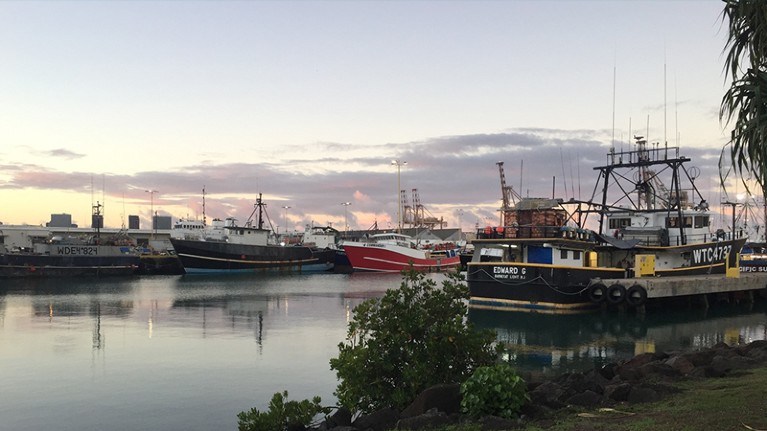[ad_1]

Longline fishing boats such as these at Honolulu’s harbour in Hawaii must respect a large no-fishing zone off the western side of the archipelago.Credit: Sarah Medoff
Large no-fishing areas can drive the recovery of commercially valuable fish species, a study suggests. Ten years’ worth of fisheries data have shown that catch rates of two important types of tuna increased drastically in the vicinity of a marine protected area surrounding the northwestern Hawaiian islands.
“It’s a win–win for fish and fishermen,” says Jennifer Raynor, an economist at the University of Wisconsin–Madison and a co-author of the study, which was published on 20 October in Science1.
The results highlight the value of large-scale marine protected areas — a type of environmental management that has emerged in the past two decades, mostly in the Pacific Ocean, says Kekuewa Kikiloi, who studies Hawaiian culture at the University of Hawaii at Mānoa. Countries around the world have committed to protecting 30% of their land and oceans by 2030.
Previous research showed that marine protected areas can help to restore populations of creatures that don’t move around much or at all, such as corals2 and lobsters3. Raynor and her colleagues wanted to test whether the areas could also drive the recovery of migratory species and provide spillover benefits for fisheries. The researchers looked at one of the largest such areas in the world, the 1.5-million-square-kilometre Papahānaumokuākea Marine National Monument, which was created in 2006 and expanded in 2016 to protect biological and cultural resources.
The team focused on the Hawaiian ‘deep-set’ longline fishery, which mainly targets yellowfin tuna (Thunnus albacares) and bigeye tuna (Thunnus obesus).
The researchers analysed catch data collected on fishing vessels between 2010 and late 2019. Then, they compared catch rates at various distances up to 600 nautical miles (1,111 kilometres) from the protected area, before and after its expansion in 2016. (The protected area itself currently extends for 200 nautical miles from the northwestern part of the Hawaiian archipelago.) They found that after the expansion, catch rates — defined as the number of fish caught for every 1,000 hooks deployed — went up, and that the increases were greater the closer the boats were to the no-fishing zone. At distances of up to 100 nautical miles, the catch rate for yellowfin tuna increased by 54%, and that for bigeye tuna by 12%. Some other types of catch rate also increased, but not by equally significant margins.
The size of the Papahānaumokuākea Marine National Monument — more than three times the surface area of California — probably played a part in the positive effects, as did its shape. It spans about 2,000 kilometres from west to east, protecting large swathes of ocean waters at tropical latitudes. This means that tropical fish such as yellowfin and bigeye tuna — which tend to move along an east–west axis to stay in their preferred temperature range — can travel a long way and still stay in the no-fishing zone.
What’s more, says Raynor, Papahānaumokuākea is a spawning ground for yellowfin tuna. Because the animals don’t travel far from their birthplace, the no-take zone provides refuge from fishing, helping tuna to aggregate and reproduce.
“It is exciting to see that there are benefits to the fishing industry from this marine protected area,” says David Kroodsma, director of research and innovation at Global Fishing Watch in Oakland, California, a US non-governmental organization that monitors fishing activity worldwide. However, he adds, it’s unclear whether the results can be generalized to other areas of the world.
Regardless, the findings could help others to design marine protected areas so that benefits trickle down to fisheries, says Steve Gaines, a marine ecologist at the University of California, Santa Barbara. The study, he says, “provides a platform to definitively evaluate what is working and what isn’t”.
Co-managed by Indigenous populations, the state of Hawaii and the US government, Papahānaumokuākea is an example of a collaborative management strategy that bridges Indigenous knowledge and modern science, Kikiloi says. The approach, he adds, “can work successfully in other places too, if given a chance”.
[ad_2]
Source link

